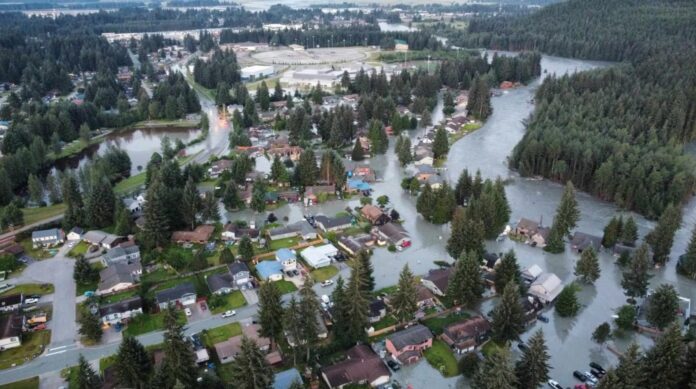Alaska Gov. Mike Dunleavy declared a state disaster emergency for the 2024 August Juneau Glacier Flood.
The Disaster Declaration funds emergency response efforts and activates the state’s Public Assistance and Individual Assistance Disaster Recovery Program.
On the morning of Aug. 6, 2024, an outburst flood from a build up of water on the east side of the Mendenhall Glacier caused major flooding in the Mendenhall Glacier Basin.

Multiple homes and roads are inundated. No reports of injuries have been reported, the Governor’s Office said..
“I am grateful no one has been injured or killed by this morning’s outburst flood. Emergency responders and managers have done an outstanding job keeping their residents safe,” Dunleavy said. ‘‘In addition to the Disaster Declaration, I have directed all state agencies to support the community as they deal with this major flooding.”
The State Emergency Operation Center (8 EOC) raised its activation level to three which indicates a disaster event has occurred. SEOC deployed a Division Supervisor and Operations Specialist to Juneau to coordinate the state disaster response and support CBJs Incident Command.
The SEOC is actively responding to emergency life, health and safety requests form CBJ and has engaged SEOC’s Mass Care group to provided assistance from volunteer and faith based agencies. The Department of Transportation and Public Facilities and Department of Public Safety are part of the ongoing response effort.
The disaster declaration has activated the state’s disaster Public Assistance and Individual Assistance disaster recovery programs. The Public Assistance program reimburses communities and jurisdictions for emergency response costs, emergency protective measures, and can fund repair of critical infrastructure damaged by the declared disaster event. The Individual Assistance program provides grants to individuals and families with damage to their primary homes or transportation, disaster related medical expenses, or other eligible disaster related expenses.
This story will be updated.

A logical and logistical call. It should and is an expectation for a government body leader to do as Govenor.Dunleavy has done with this proclamation. Now, Sir, might you consider doing the same for the ferry system?? While not a natural disaster, a disaster in the making with this same Govenor Dunleavy at the helm as the system sinks. The very next in context, minor breakdown and the system to Bellingham or Westward, comes to a complete stop. It is almost as if the Governor over the past budgets has by design, demonstrated a diabolical death by a thousand cuts in a desire to end the system. Let me end this with a confirmation on a good call regarding the flooding.
“
Juneau needs to take back moneys for politicians digs and wasteful city shrines and use it for flood control.
Damn, this was bad.
I’m no fan of Dunleavy, but do appreciate the help.
I’m a bit curious looking at the pictures here. Why with flooding like this are all those cars parked there? And the one person with a boat has it hitched to a truck facing the water. Are these legislator’s homes?
Insurance claims.
They had prior knowledge and now they get a new car.
The crest appeared to be as expected, then the water started rising again and raised a foot higher than expected and it overtopped some raised areas and quickly innundated many lower areas with 3-4 feet of water that hdd been dry minutes before. In minutes water was rushing through neighborhoods at 230 in the morning after folks had gone to been when they thought the worst was over,
I guess the Leftist in YouKnow haven’t heard about the water levels are arising (tongue in cheek). A responsible leftist would be on higher ground!
Hypocrites all of you
Why do people build in flood plain areas? A more pertinent question is, why do insurance companies insure those homes?
Only NFIP insures homes in flood areas. Flooding is excluded in a srandard property insurance policy.
OK, why does NFIP insure homes in flood prone areas? And why should the state pay people who have built homes in flood prone areas when their homes become flooded?
Now those are better questions. As a Risk Manager by trade, I can assure you that the old adage of location, location, location still apply to natural hazards.
Now. About the NFIP:
“As of April 2024, the National Flood Insurance Program (NFIP) owes $20.525 billion to the U.S. Treasury, with $9.9 billion in remaining borrowing authority. The NFIP incurred this debt after paying claims for catastrophic flood disasters following Hurricane Katrina. The NFIP must refinance its debt at current interest rates, which average 3.02%, and pays interest out of premium dollars collected. This results in the program accruing $1.7 million in interest per day, or $619 million annually.”
Just as bad as the USPS.
Subsidizing risk has never really been a good idea. But until the CBJ starts limiting development in the Mendenhall floodplain, it is what it is.
You are right, though. We are WE paying for it Federally?